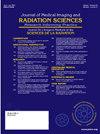CT模拟过程中静脉造影剂中心静脉通路装置选项的实施
IF 1.3
Q3 RADIOLOGY, NUCLEAR MEDICINE & MEDICAL IMAGING
Journal of Medical Imaging and Radiation Sciences
Pub Date : 2025-05-01
DOI:10.1016/j.jmir.2025.101940
引用次数: 0
摘要
目的/目的在放射CT模拟时经常使用静脉造影来增强关键解剖结构的可见性,为临床团队规划放射治疗提供重要信息。在我们的机构,当放射肿瘤学家(RO)要求静脉造影剂时,患者会在CT模拟之前立即与护士预约,在此期间他们会插入静脉注射。对于一些患者来说,静脉注射是极具挑战性或不可能的,通常这些信息在CT模拟预约之前就已经知道了。这些挑战导致静脉造影剂不是可行的选择,在与放射肿瘤学家(RO)讨论后,CT模拟在没有造影剂的情况下进行。这对于放射治疗计划来说是不理想的,因为ROs必须依靠诊断图像来描绘目标,而由于患者体位和解剖结构的差异,图像融合可能很困难。许多放疗患者有现有的中心静脉通路装置(CVAD),用于全身治疗的输送。实践创新的目的是探索实施CVAD选项来管理CT模拟目的的静脉造影剂的可行性。我们医院的诊断成像(DI)部门在CT扫描期间常规使用CVADs进行造影剂给药。DI部门的放射技术人员通过CVADs进入、管理造影剂和去通路线。在与我们机构DI的首席主管技术专家的访问中,我们工作组的成员能够获得有关其流程和程序的知识和见解,并将安全作为优先事项和目标。随后,工作组从各个放射治疗部门寻求具体反馈,以确认需要对对比和扫描方案进行任何调整。利用我们IT部门的专业知识,工作组在临床信息系统中开发了一套新的订单集,该订单集将支持RO通过CVAD订购对比剂的选择。这组订单包括具体的预约、获得和取消获得CVAD护理的订单,以及在发生造影剂引起的过敏反应时所需的紧急药物订单。结果或益处/挑战对于现有CVAD静脉通路不良的患者来说,这是一个显著的益处。这为患者提供了公平的护理,并有能力确保CT图像的充分描绘,以实现放射计划的目的。预见到的一个潜在挑战是大量的CVAD请求,因此最初的实施包括那些已知困难的患者群体,而不是所有现有的CVAD患者。这是为了逐步实施,以评估对所需资源的影响,特别是增加了取消使用CVAD的预约。结论/影响迄今为止,已有几名患者利用CVAD进行扫描并计划进行放射治疗。来自临床团队的反馈是积极的,但我们计划直接从这些患者那里寻求更正式的反馈,以确保我们满足他们的需求,并确定任何改进的机会。本文章由计算机程序翻译,如有差异,请以英文原文为准。
Implementation of Central Venous Access Device Option for IV Contrast Administration during CT Simulation
Purpose/Aim
Intravenous (IV) contrast is frequently utilized at the time of radiation CT Simulation to enhance visibility of critical anatomical structures, providing important information for the clinical team when planning for radiation treatments. At our institution, when IV contrast is ordered by the Radiation Oncologist (RO), patients are booked for an appointment with a nurse immediately prior to CT Simulation, during which they have an IV inserted. For some patients, IV initiation is extremely challenging or impossible and often this information is known in advance of the CT Simulation appointment. These challenges have resulted in scenarios where IV contrast was not a feasible option and in discussion with the Radiation Oncologist (RO), CT Simulation was performed without contrast. This is less than ideal for radiation treatment planning, as ROs must then rely on diagnostic images for target delineation, where image fusion can be difficult due to differences in patient position and anatomy. Many radiation patients have existing Central Venous Access Devices (CVAD), for the purposes of systemic therapy treatment delivery. The aim of the practice innovation was to explore the feasibility of implementing a CVAD option to administer IV contrast for CT Simulation purposes.
Methods/Process
The Diagnostic Imaging (DI) Department at our institution routinely utilizes CVADs for the purposes of contrast administration during CT scans. Radiological Technologists in the DI department access, administer contrast and de-access lines via CVADs. During a visit with the lead charge technologist in DI at our institution, members of our working group were able to gain knowledge and insights regarding their processes and procedures with safety being the priority and goal. Subsequently, the working group sought specific feedback from various radiation therapy departments to confirm any adjustments required to contrast and scanning protocols. Utilizing the expertise of our IT department, the working group developed a new order set within the clinical information system that would support the option for the RO to order contrast administration through CVAD. This order set includes specific appointments, orders for accessing and de-accessing the CVAD for nursing as well as orders for as needed emergency medications in the event of contrast induced anaphylaxis.
Results or Benefits/Challenges
This is a significant benefit to patients with poor venous access with an existing CVAD. This provides patients with equitable care and the ability to ensure adequate delineation of CT images for radiation planning purposes. A potential challenge foreseen was a large number of requests for CVAD and therefore the initial implementation included a select patient population of those who had known difficulties rather than all patients with existing CVADs. This was to allow a gradual implementation to assess impacts on resources required, specifically the addition of an appointment for de-accessing the CVAD.
Conclusions/Impact
To date, there have been several patients scanned and planned for radiation treatment utilizing the CVAD for contrast purposes. Feedback from the clinical team has been positive, however we plan to seek more formal feedback from these patients directly to ensure we are meeting their needs and to determine any opportunities for improvement.
求助全文
通过发布文献求助,成功后即可免费获取论文全文。
去求助
来源期刊

Journal of Medical Imaging and Radiation Sciences
RADIOLOGY, NUCLEAR MEDICINE & MEDICAL IMAGING-
CiteScore
2.30
自引率
11.10%
发文量
231
审稿时长
53 days
期刊介绍:
Journal of Medical Imaging and Radiation Sciences is the official peer-reviewed journal of the Canadian Association of Medical Radiation Technologists. This journal is published four times a year and is circulated to approximately 11,000 medical radiation technologists, libraries and radiology departments throughout Canada, the United States and overseas. The Journal publishes articles on recent research, new technology and techniques, professional practices, technologists viewpoints as well as relevant book reviews.
 求助内容:
求助内容: 应助结果提醒方式:
应助结果提醒方式:


